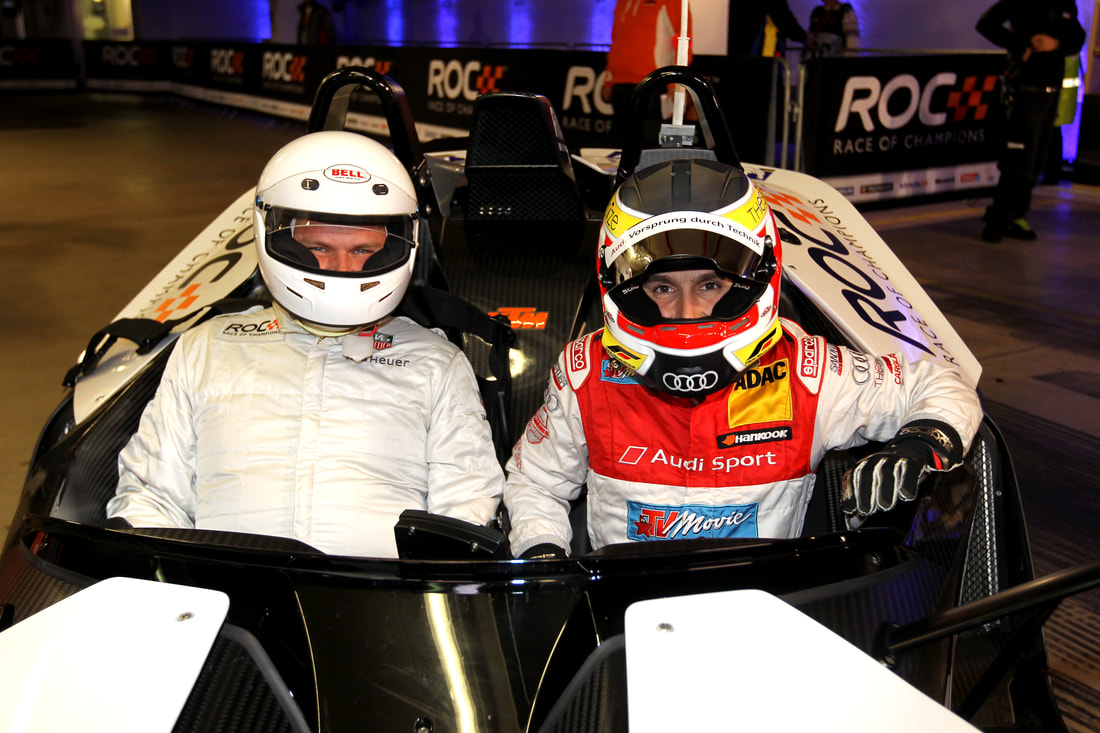|
Some days really are ‘your day’. November 28, 2010 was Filipe Albuquerque’s day as this young Portuguese racer emerged from obscurity to defeat a line-up of legends – including Sebastian Vettel, Michael Schumacher and Alain Prost, who have 15 F1 world titles between them – to take the Race Of Champions crown at his first attempt.
Ho hum, not bad. But today was my day. I don’t believe you can ask Nadia Comaneci or Usain Bolt for a piggy back to get a close-up of what they do. Yet here I was lapping the same twisty racetrack inside a Düsseldorf football stadium – in the passenger seat one year later as Albuquerque revved the very KTM X-Bow he had used to defeat Vettel. I was soon given no doubt about how seriously Albuquerque was taking this. Even on the supposedly gentle run to the start line he ensured the car rarely felt like a car at all. As he put heat in the tyres with a series of weaves and burnouts, the X-Bow would suddenly feel unsettlingly light as if we were on a futuristic hoverboard. By the time we were waved away for the actual timed laps I admit to losing circulation in my knuckles: mercifully this was to be a short run or my typing days were over. As the lights went out and we lurched forwards I knew I had to suspend every idea I’d ever cultivated about the speed that corners should be taken. The track also featured a specially-built 100-tonne crossover bridge linking its two loops, like a giant Scalextric set. I now understand why bridges do not feature more widely in motor sport: on entry, all you can see is the top tier of the stands. As we launched skywards at full throttle all evidence suggested our inevitable final destination would be Row Z. Yet as soon as the laws of physics overcame any brief moment of ‘air’ my nonchalant chauffeur was on the anchors for the next right-hander. With the reflex of self-preservation beaten into submission, I focused the rest of my simpering mental capacity on the majesty of Albuquerque’s skill. That was not hard because racing at the top level is an art. He didn’t just hurl the X-Bow round the track, he danced. Every time the back end skipped out this leading man teased it back in line and away we shimmied round the floor, whirls seamlessly blending into reels and pirouettes. Too soon it was over and I let fly with the whoop I’d been stifling for fear of breaking the concentration of the maestro beside me. Some chance… ‘Being a racing driver is all about chasing the perfect lap,’ says Albuquerque. ‘Getting to the limit is what gives us the pleasure. When you put on new tyres you are so much faster everywhere and the feeling is amazing. You go corner by corner and you’re not thinking about the lap. You just push to the absolute limit, almost locking the front wheels. I like oversteer so I need to feel a little slide at the rear otherwise I feel too safe. I don’t breathe on the fast corners to make sure there is no movement at all, I just swerve it out. When all this comes together it’s fantastic. ‘The feeling is unbelievable and really makes you happy. You feel arrogant, like “Damn I’m good” – not meaning no one can beat you, but that this was a perfect lap, one you would like to show your friends. You think, “Wow. If someone beats me I’ll shake their hand because they’re definitely faster than me.” ‘Sometimes I can’t even explain to myself how I could do it. You look at the time and think, “How did I do that?” I don’t know but I’m not bothered. You don’t even need to see the data to know no one will beat you because the car has really gone beyond the limit. The secret is just to let it happen like you think it will. Be yourself in the car, be natural and just do it. If you go faster, awesome, if not keep trying.’ To make it big in motor racing you clearly have to nail this perfect lap when it really matters, preferably with monotonous regularity. Albuquerque, who now focuses on endurance racing, recalls one such lap when he took Nürburgring pole by half a second in Formula Renault. But after he was snapped up by Red Bull’s young driver programme, his results weren’t consistent enough and he was dumped. He was racing in an unglamorous category of Italian GTs when he won a regional qualifying event for the Race Of Champions. That’s when he grabbed his chance. ‘It just felt like my day,’ he beams. ‘I was happy to have a chance to compare my speed with the best guys in the world. I felt good in every car and I nailed it. The races were like qualifying laps. I had many corners when I said this was just perfect, going right up to the wall and sweeping down. I was braking very late but not too late, turning in and flicking the car just right. Of course I made some small mistakes during the event because it’s not possible to do ten races with no mistakes. But you need to make a judgement about how many risks to take. ‘For the final against Sébastien Loeb I just went in thinking I’d do my best and try to perform like I’d pictured in my mind. Then let’s see how my speed compares to him with my perfect lap. He was on it, too. I beat him by a hundredth in the first heat of the final, then made a small mistake in heat two and he beat me by two hundredths. In the decider I pushed very hard, almost crashing all the time, but made no mistakes. So my perfect lap was enough to beat him and everyone in the Race Of Champions.’ Nine-time world rally champion Loeb confirms he was beaten fair and square by this relative unknown: ‘I gave everything and did a good race but he was just a bit faster. He was just flying…’ This extract is from In The Zone: How Champions Think and Win Big. Out now…
0 Comments
Your comment will be posted after it is approved.
Leave a Reply. |
AuthorClyde Brolin spent over a decade working in F1 before moving on to the wider world of sport - all in a bid to discover the untapped power of the human mind. Archives
October 2024
Categories
All
|




 RSS Feed
RSS Feed

